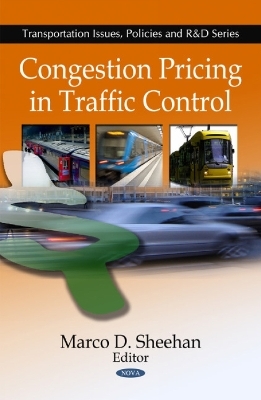
Congestion Pricing in Traffic Control
Seiten
2010
Nova Science Publishers Inc (Verlag)
978-1-60741-963-1 (ISBN)
Nova Science Publishers Inc (Verlag)
978-1-60741-963-1 (ISBN)
Congestion costs highway users billions of dollars every year. This book explains how congestion pricing works, reviews the best available evidence on projects that make use of such pricing in order to assess the benefits and challenges of the approach, and discusses federal policy options for encouraging congestion pricing.
Congestion costs highway users billions of dollars every year. Although policymakers have adopted a variety of strategies for reducing or mitigating congestion, relatively little attention has been paid to policies to promote more efficient use of the highway system. One such policy is congestion pricing, under which drivers are charged a higher price for use of a highway at times or places with heavy traffic and a lower price in the opposite circumstances. This book explains how congestion pricing works, reviews the best available evidence on projects that make use of such pricing in order to assess the benefits and challenges of the approach, and discusses federal policy options for encouraging congestion pricing. Congestion pricing also can be linked to strategies to improve mobility by making alternatives to the private automobile, such as subways, buses or commuter rail service, more attractive during peak periods. The revenues generated by such pricing have sometimes been used to pay for improvements in public transportation systems. This book consists of public documents which have been located, gathered, combined, reformatted, and enhanced with a subject index, selectively edited and bound to provide easy access.
Congestion costs highway users billions of dollars every year. Although policymakers have adopted a variety of strategies for reducing or mitigating congestion, relatively little attention has been paid to policies to promote more efficient use of the highway system. One such policy is congestion pricing, under which drivers are charged a higher price for use of a highway at times or places with heavy traffic and a lower price in the opposite circumstances. This book explains how congestion pricing works, reviews the best available evidence on projects that make use of such pricing in order to assess the benefits and challenges of the approach, and discusses federal policy options for encouraging congestion pricing. Congestion pricing also can be linked to strategies to improve mobility by making alternatives to the private automobile, such as subways, buses or commuter rail service, more attractive during peak periods. The revenues generated by such pricing have sometimes been used to pay for improvements in public transportation systems. This book consists of public documents which have been located, gathered, combined, reformatted, and enhanced with a subject index, selectively edited and bound to provide easy access.
Preface; Congestion Pricing: A Primer; Using Pricing to Reduce Traffic Congestion; Value Pricing Pilot Program- Lessons Learned; Index.
| Erscheint lt. Verlag | 1.7.2010 |
|---|---|
| Zusatzinfo | Illustrations |
| Verlagsort | New York |
| Sprache | englisch |
| Maße | 260 x 180 mm |
| Gewicht | 608 g |
| Themenwelt | Recht / Steuern ► EU / Internationales Recht |
| Recht / Steuern ► Strafrecht ► Besonderes Strafrecht | |
| ISBN-10 | 1-60741-963-7 / 1607419637 |
| ISBN-13 | 978-1-60741-963-1 / 9781607419631 |
| Zustand | Neuware |
| Haben Sie eine Frage zum Produkt? |
Mehr entdecken
aus dem Bereich
aus dem Bereich
eine praxisorientierte Darstellung
Buch | Softcover (2024)
C.H.Beck (Verlag)
69,00 €


